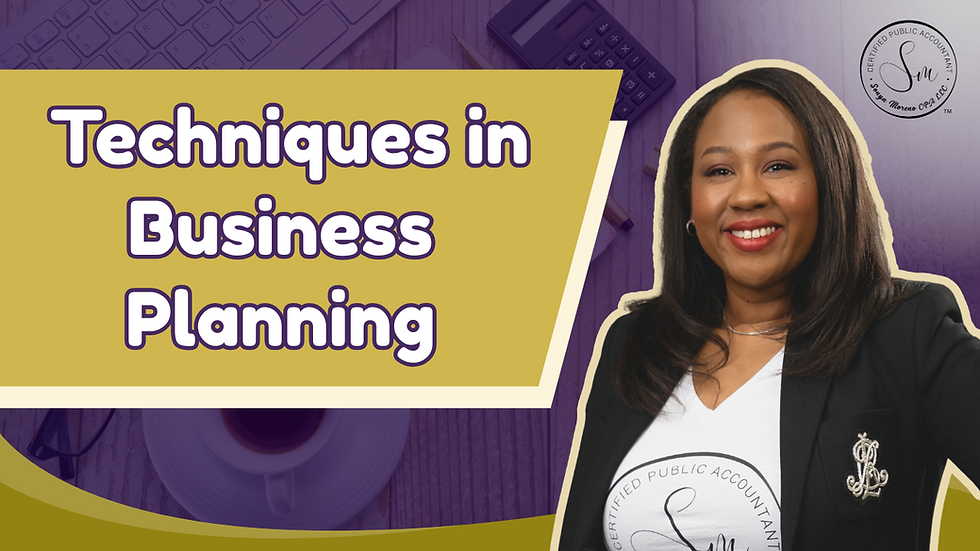Techniques in Business Planning
- sonya9686
- Aug 22
- 3 min read
Every successful business is built on a foundation of solid planning. But effective business planning isn’t just about writing a one-time document and filing it away. It’s a layered process that involves different types of plans working in harmony—each with its own purpose, timing, and impact. In this blog, we’ll break down three essential planning techniques that every business owner should understand: the business plan, the marketing plan, and the strategic plan.
Prefer to watch instead?
I also break down these three types of planning in my YouTube video — showing you how the business plan, marketing plan, and strategic plan work together to give your business clarity, focus, and sustainable growth.
The Business Plan: Your Vision Blueprint
The business plan is often the first step for any new business owner. It’s typically created once, usually in the early stages of launching your company, and is designed to define the why, what, and how of your business. This plan sets the long-term vision and outlines the core foundation of your company. Key components of a strong business plan include:
Executive summary
Company description
Market analysis
Organizational structure
Product or service line
Funding request (if applicable)
Financial projections
While the foundational business plan is often created once, it should be a living document that is formally reviewed and updated at least annually, and more frequently if significant changes occur (e.g., new products, market shifts, funding rounds). It provides direction and ensures the company remains aligned with its original goals. It’s especially useful when seeking outside funding or partnerships.
The Marketing Plan: Your Growth Engine
Unlike the static nature of a business plan, a marketing plan is a dynamic, evolving document. It’s unique to your company’s voice, audience, and goals—and it should be updated frequently based on real-world results. Your marketing plan outlines how you’ll reach your customers and grow your presence. It defines strategies for brand awareness, lead generation, sales conversion, and client retention. A good marketing plan typically includes:
Target audience profiles
Unique value proposition (UVP)
Messaging strategy
Marketing channels (digital, print, social media, etc.)
Content calendar
Budget and KPIs (Key Performance Indicators)
The goal is to create a plan that is trackable and flexible. Your marketing should evolve as your business grows and as customer behavior shifts.
The Strategic Plan: Your Execution Roadmap
The strategic plan is where the real work happens. While the business plan sets the vision and the marketing plan drives visibility, the strategic plan outlines the how—the tasks, goals, and actions needed to execute and grow the business. Strategic plans operate on multiple timelines:
Weekly tasks: Ongoing actions that keep daily operations running (e.g., managing inventory, customer service, team meetings)
Monthly priorities: Projects with short-term goals (e.g., launching a new product, analyzing monthly KPIs)
Annual objectives: Long-term goals (e.g., expanding to a new market, hitting annual revenue targets)
This plan evolves regularly and should be reviewed consistently. It keeps you accountable, identifies bottlenecks early, and helps track both progress and performance.
Why These Plans Matter Together

Each plan has its own role, but they’re most powerful when used together. A business plan without execution leads nowhere. A marketing plan without strategy wastes money. A strategic plan without vision lacks direction. When these three are aligned:
You have a clear vision (business plan)
You’re actively attracting and serving customers (marketing plan)
You’re tracking and achieving your goals (strategic plan)
Together, they give your business the structure it needs to grow with clarity and confidence.
Final Takeaway
Business planning isn’t a one-and-done task. It’s an ongoing, layered process that evolves with your company. Whether you’re just starting out or looking to grow, understanding the differences between your business plan, marketing plan, and strategic plan—and using them together—will set you up for long-term success. If you’re unsure where to start or need help building any of these plans, consider working with a business advisor who can walk you through the process and tailor each component to your goals.





Comments